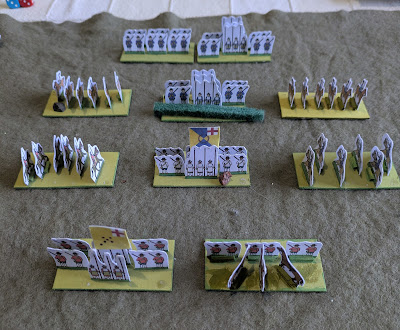After a strong start in 1642, things went badly for the Royalists in 1643 and they are close to defeat. In 1644 they needed to take the offensive and try and gain more control of the country. If Parliament attacked and win in any region then the war would be over.
1644 -1
The year started badly for the Royalists. East Anglia was the active area, with their options being the North Midlands or Yorkshire. Either area would so so I diced for it and Parliament marched into the North Midlands.
Game 5 - The Battle of Normanton
Royalists - 1 x Horse, 1 x Defended Horse*, 1 x Melee Foot in Defences, 1 x Missile Foot, 1 x Shot
Parliament - 1 x Horse, 1 x Elite Horse, 1 x Elite Missile Foot, 1 x Missile Foot, 1 x Dragoons
*Representing a large unit.
*Representing a large unit.
The Parliamentarians under William Waller encountered a Royalist army under Lord Standing near the village of Normanton. The Royalist centre was based around a sunken lane, whilst their right wing was covered by a large force of locally raised horse. Parliament's horse on the left wing was commanded by an enthusiastic colonel called Oliver Cromwell, who had trained his men to a high degree of efficiency.
The initial artillery bombardment had no effect.
Turn 1 - With the Royalist cause looking close to collapse Parliament's army was highly enthusiastic, and Waller exploited this by sending in his foot in the centre to clear the sunken lane. Fierce fighting saw them thrown back in disarray.
As more Parliamentarian foot was fed into the fight the Royalists held firm. Parliament's attack stalled. And Waller moved up his dragoons to cover the centre.
Parliament rallied the best of their foot and prepared for another attack.
Turn 2 - Waller changed tack and ordered Cromwell's horse forward on his left. They easily defeated the local horse, driving them from the field. The Royalist foot now faced the enemy horse.
The Royalists countered by committing their horse on the right flank, and an inconclusive fight developed. The foot of both sides moved up to support that flank.
Turn 3 - The newly rallied Parliamentarian foot now attempted to outflank the sunken road, but ran into Royalist shot who stalled their attack. The two sides settled into a shooting match.
The Royalists responded by attacking along the lane, scattering Parliament's dragoons.
Turn 4 - The Parliamentarian foot continued its exchange with the Royalist shot, but with their flanks now compromised they withdrew from the field, covered by Cromwell's horse.
This Royalist win prevented their defeat once more.
1644 - 2
The fickle finger of fate saw East Anglia as the active area again and, once more, Parliament attacked the North Midlands. Driving west they captured Leicester, but a Royalist army under Prince Maurice shadowed them. The Parliamentarian army formed up at Bosworth to meet the Royalist attack.
Game 6 - The Battle of Bosworth
Royalists - 2 x Horse, 2 x Missile Foot, 1 x Shot, 1 x Dragoons
Parliament - 2 x Horse, 1 x Armoured Horse, 1 x Missile Foot in Defences, 1 x Missile Foot
Parliament's position was centred around some rising ground, whilst their hope was to rely on their superiority in horse on the wings.
The Royalists went for a bold assault, sending in a massed cavalry attack supported by dragoons.
The Royalists went for a bold assault, sending in a massed cavalry attack supported by dragoons.
Once again the initial artillery bombardment had no effect on either side.
Turn 1 - Royalist horse surged forward in the centre, straight up the hill and shattered Parliament's foot. Parliament covered the infantry with their reserve horse.
Parliament's cuirassiers charged on the left flank, and a length melee saw both sides exhausted.
Turn 2 - The left flank settled into an exchange of musketry, but the Royalist shot pushed forward with surprising aggression and quickly broke Parliament's regiments.
A cavalry duel in the centre saw both sides shattered. This epic encounter saw the loss of the official war artists on both sides, so no illustration survives. This final engraving is based on a sketch by Prince Maurice himself and shows the victorious Royalist army.
Parliament had begun 1644 confident of a quick win, but two campaigns in the Midlands had both been defeated by an energetic Royalist defence. The situation was still dire for the Royalist cause, but they had held on for another year.
















It will be interesting to see if the royalists can build off of their two victories and seize the initiative.
ReplyDeleteThe problem is that they are defensive victories so only prevent the Royalists losing. They need a chance to go on the offensive somewhere.
DeleteThis is an excellent campaign, very exciting although it is hard to see how the Royalists can turn things around. The new force generator seems to be working well too. I'm looking forward to trying this out myself when I have a chance.
ReplyDeleteGreat reports - really enjoying reading about this campaign, Kaptain. Hoping the war artists are soon replaced, allowing more engravings to grace the blog in the near future 😁
ReplyDeleteEnjoying reading the latest episode of this campaign - or should it really be war?
ReplyDeleteDid you receive my draft siege rules sent to your email on 5th July? Perhaps check your spam box if my mail doesn't appear.